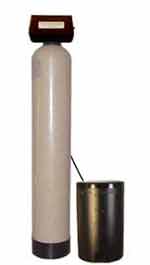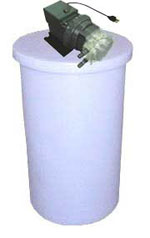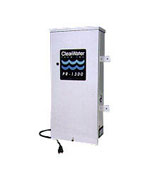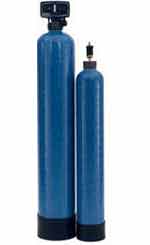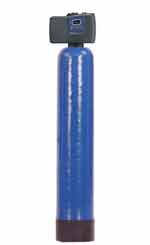The maximum contaminant level (MCL) for iron set by USEPA standards is 0.3 ppm, also referred to as 0.3 milligrams per liter of water. In concentrations above 0.3 ppm, iron in water can cause staining of fixtures and porcelain, and ruin laundry.
A bittersweet astringent taste is detectable at concentrations above 0.5 ppm by many people. Manganese is often found with iron, and causes brown, black and/or tea-colored staining, and imparts asphaltic and oily tastes, above .05 ppm. Some of the same filters used for iron, are used for manganese removal.
Iron and manganese are often found in a dissolved state in well waters, and the water appears clear when first drawn. Upon exposure to air, or after the addition of oxidants (such as chlorine bleach or ozone), this ferrous iron is oxidized ("rusted") to the ferric state to form insoluble particles. The water then looks orange or yellow, or in the case with manganese, brown or black. This can happen in toilet flush tanks and in the washing machine or dishwasher. We also frequently find iron that is complexed or "bound up" with organic matter, in organic iron complexes that are dissolved in water. In this case, chlorination or ozone is injected prior to filtration. Iron is commonly treated with automatic iron filters, which can remove both dissolved and oxidized iron compounds. If sulfur odor is present along with iron, typically chlorine or ozone is fed ahead of an iron filter. In some cases, a backwashing self-cleaning sediment filter can be used in place of an iron filter, if all the iron and manganese has been oxidized to a solid state after the chlorination, ozone injection or air injection process.
There are several different types of iron filters used, depending on the type and quantity of iron, and the application. Some iron filters, such as the greensand iron filter, remove iron, manganese and sulfur odors. Others such as the Terminator brand use air injection. Often these systems are used after the water has been pretreated with aeration, chlorine or ozone. Birm iron filters work great for iron, but work less well on manganese, and cannot be used where the water contains sulfur odors, chlorine or low pH.
The role of pH is very important in iron treatment. Generally, if the pH of the water is acidic (or less than 7.0), it must be corrected with a special type of neutralizer filter ahead of the iron filtration system. It is usually best to test for pH right at the water source, and not depend on laboratory analysis for pH, since in some cases the pH can raise after sampling, giving false results. Water softening is sometimes used to remove dissolved iron in low levels (less than 2.0 ppm), although more commonly, we use iron filters in conjunction with water softening if the water is both hard, and high in iron or manganese. Iron is generally not thought of as toxic, although there are some studies that show liver toxicity to men.
Often color in water is caused by iron or manganese. Water high in iron or manganese can sometimes be red, rust colored, brown, tan, black, or greenish in color. A well designed iron filter can be very effective at removing these oxidized iron particles.
There are many different designs and application criteria that must be considered, including water chemistry, flow rates, how the water will be disinfected, and what types of filtration to use. In some cases additional treatment such as reverse osmosis or other types of membrane filtration, such as nano-filtration are used in place of or in conjunction with polymer injection and settling, for color removal.
Need help selecting a system? Fill out our quick and easy Water System Designer Form and get a response in 24 hours or less.
Read Frequently Asked Questions:
About Greensand Filters and About Birm Iron Filters
